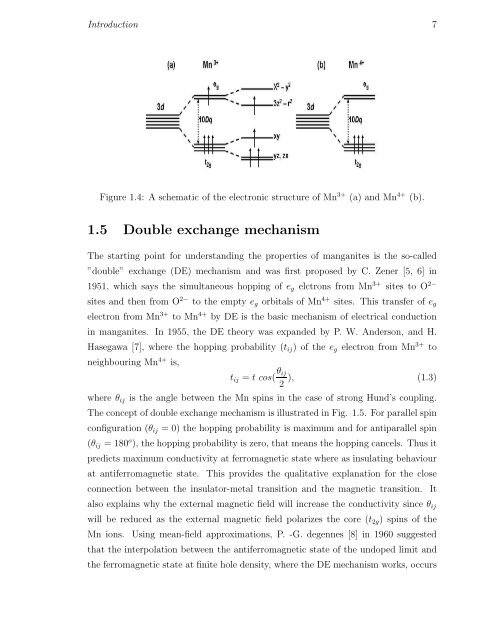PHYS07200604007 Manas Kumar Dala - Homi Bhabha National ...
PHYS07200604007 Manas Kumar Dala - Homi Bhabha National ...
PHYS07200604007 Manas Kumar Dala - Homi Bhabha National ...
Create successful ePaper yourself
Turn your PDF publications into a flip-book with our unique Google optimized e-Paper software.
Introduction 7<br />
Figure 1.4: A schematic of the electronic structure of Mn 3+ (a) and Mn 4+ (b).<br />
1.5 Double exchange mechanism<br />
The starting point for understanding the properties of manganites is the so-called<br />
”double” exchange (DE) mechanism and was first proposed by C. Zener [5, 6] in<br />
1951, which says the simultaneous hopping of e g elctrons from Mn 3+ sites to O 2−<br />
sites and then from O 2− to the empty e g orbitals of Mn 4+ sites. This transfer of e g<br />
electron from Mn 3+ to Mn 4+ by DE is the basic mechanism of electrical conduction<br />
in manganites. In 1955, the DE theory was expanded by P. W. Anderson, and H.<br />
Hasegawa [7], where the hopping probability (t ij ) of the e g electron from Mn 3+ to<br />
neighbouring Mn 4+ is,<br />
t ij = t cos( θ ij<br />
), (1.3)<br />
2<br />
where θ ij is the angle between the Mn spins in the case of strong Hund’s coupling.<br />
The concept of double exchange mechanism is illustrated in Fig. 1.5. For parallel spin<br />
configuration (θ ij = 0) the hopping probability is maximum and for antiparallel spin<br />
(θ ij = 180 o ), the hopping probability is zero, that means the hopping cancels. Thus it<br />
predicts maximum conductivity at ferromagnetic state where as insulating behaviour<br />
at antiferromagnetic state. This provides the qualitative explanation for the close<br />
connection between the insulator-metal transition and the magnetic transition. It<br />
also explains why the external magnetic field will increase the conductivity since θ ij<br />
will be reduced as the external magnetic field polarizes the core (t 2g ) spins of the<br />
Mn ions. Using mean-field approximations, P. -G. degennes [8] in 1960 suggested<br />
that the interpolation between the antiferromagnetic state of the undoped limit and<br />
the ferromagnetic state at finite hole density, where the DE mechanism works, occurs
















